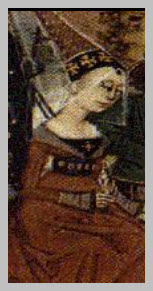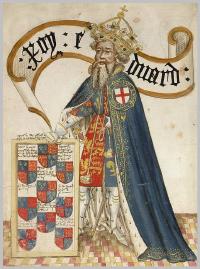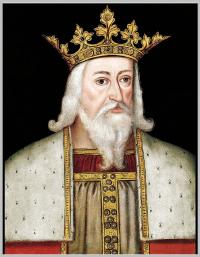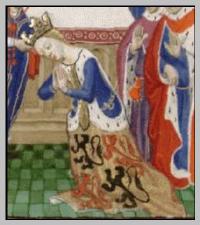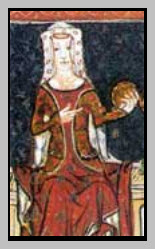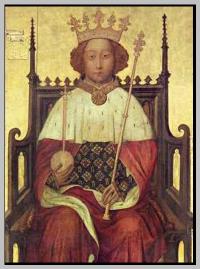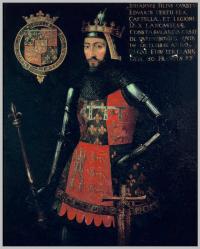Isabella (?) of France1
F, b. 1295, d. 22 August 1358
Link Edward III (?)1
M, b. 13 November 1312, d. 21 June 1377
| Birth* | 13 November 1312 | Link Edward III (?) was born on 13 November 1312.1 |
| Death* | 21 June 1377 | He died on 21 June 1377 at age 64.1 |
| Reign* | between 1327 and 1377 | He reigned between between 1327 and 1377.2 |
John of Eltham (?)1
M, b. 15 August 1316, d. 13 September 1336
| Birth* | 15 August 1316 | John of Eltham (?) was born on 15 August 1316.1 |
| Death* | 13 September 1336 | He died on 13 September 1336 at age 20; No issue.1 |
Eleanor of Woodstock Eleanor (?)1
F, b. 13 June 1318, d. 22 April 1355
| Birth* | 13 June 1318 | Eleanor of Woodstock Eleanor (?) was born on 13 June 1318.1 |
| Death* | 22 April 1355 | She died on 22 April 1355 at age 36.1 |
Joan (?) of The Tower1
F, b. 5 July 1321, d. 7 September 1362
| Birth* | 5 July 1321 | Joan (?) of The Tower was born on 5 July 1321.1 |
| Death* | 7 September 1362 | She died on 7 September 1362 at age 41; No issue.1 |
Edward III (?)1
M, b. 13 November 1312, d. 21 June 1377
| |
|  |
| Birth* | 13 November 1312 | Edward III (?) was born on 13 November 1312 at Windsor Castle.1,2 |
| Marriage* | October 1327 | He married Philippa of Hainault (?) in October 1327 at Valenciennes; By Proxy.3 |
| Marriage | 24 January 1328 | Edward III (?) married Philippa of Hainault (?) on 24 January 1328 at York Minster, York; Formal cerimony of marriage.3 |
| Death* | 21 June 1377 | Edward III (?) died on 21 June 1377 at age 64.1 |
| Burial* | | He was buried.4 |
| Note* | | He Edward III (13 November 1312 – 21 June 1377) was King of England and Lord of Ireland from January 1327 until his death; he is noted for his military success and for restoring royal authority after the disastrous and unorthodox reign of his father, Edward II. Edward III transformed the Kingdom of England into one of the most formidable military powers in Europe. His long reign of 50 years was the second longest in medieval England and saw vital developments in legislation and government—in particular the evolution of the English parliament—as well as the ravages of the Black Death.
Edward was crowned at age fourteen after his father was deposed by his mother, Isabella of France, and her lover Roger Mortimer. At age seventeen he led a successful coup against Mortimer, the de facto ruler of the country, and began his personal reign. After a successful campaign in Scotland he declared himself rightful heir to the French throne in 1337. This started what became known as the Hundred Years' War.[1] Following some initial setbacks the war went exceptionally well for England; victories at Crécy and Poitiers led to the highly favourable Treaty of Brétigny, in which England made territorial gains, and Edward renounced his claim to the French throne. Edward's later years were marked by international failure and domestic strife, largely as a result of his inactivity and poor health.2 |
| Reign* | between 1327 and 1377 | He reigned between between 1327 and 1377.4 |
| Coronation* | 1 February 1327 | He was coronated on 1 February 1327 at (?) Westminster.4,2 |
| Note | 19 October 1330 | Edward III (?) Attacked Mortimer, and had him executed for treason. This began Edward III reigh in his own right. on 19 October 1330 at Nottingham Castle.2 |
| Note | 1337 | He In 1337, Philip VI confiscated the English king's Duchy of Aquitaine and the county of Ponthieu. Instead of seeking a peaceful resolution to the conflict by paying homage to the French king, as his father had done, Edward responded by laying claim to the French crown as the grandson of Philip IV.[26] The French rejected this based on the precedents for agnatic succession set in 1316 and 1322. Instead, they upheld the rights of Philip IV's nephew, King Philip VI (an agnatic descendant of the House of France), thereby setting the stage for the Hundred Years' War in 1337.2 |
Philip IV of France (?)1
M, b. 1268, d. 29 November 1314
| Birth* | 1268 | Philip IV of France (?) was born in 1268.1 |
| Marriage* | 16 August 1284 | He married Joan I of Navarre (?) on 16 August 1284.2 |
| Death* | 29 November 1314 | Philip IV of France (?) died on 29 November 1314.1 |
| Reign* | between 1285 and 1314 | He reigned between between 1285 and 1314.1 |
Joan I of Navarre (?)1
F, b. 14 January 1273, d. 31 March 1305
| Birth* | 14 January 1273 | Joan I of Navarre (?) was born on 14 January 1273.1 |
| Marriage* | 16 August 1284 | She married Philip IV of France (?) on 16 August 1284.1 |
| Death* | 31 March 1305 | Joan I of Navarre (?) died on 31 March 1305 at age 32.1 |
Margaret (?)1
F, b. 1288, d. circa 1294
| Birth* | 1288 | Margaret (?) was born in 1288.1 |
| Death* | circa 1294 | She died circa 1294.1 |
Louis X of France (?)1
M, b. 4 October 1289, d. 5 June 1316
| Birth* | 4 October 1289 | Louis X of France (?) was born on 4 October 1289.1 |
| Death* | 5 June 1316 | He died on 5 June 1316 at age 26; His only surviving male hier was John, who was born after Louis's death and lived for only five days.1 |
| Reign* | between 1314 and 1316 | He reigned between between 1314 and 1316.1 |
Blanche (?)1
F, b. 1290, d. circa 1294
| Birth* | 1290 | Blanche (?) was born in 1290.1 |
| Death* | circa 1294 | She died circa 1294.1 |
Philip V of France (?)1
M, b. circa 1293, d. 3 January 1322
| Birth* | circa 1293 | Philip V of France (?) was born circa 1293.1 |
| Marriage* | circa 1306 | He married Joan II Countess of Burgundy (?) circa 1306.1 |
| Death* | 3 January 1322 | Philip V of France (?) died on 3 January 1322; Dysentery - No male hiers.1 |
| Reign* | between 1316 and 1322 | He reigned between between 1316 and 1322.1 |
Joan II Countess of Burgundy (?)1
F, b. 15 January 1292, d. 21 January 1330
Charles IV (of France) (?)1
M, b. 1294, d. 1 February 1328
| Birth* | 1294 | Charles IV (of France) (?) was born in 1294.1 |
| Death* | 1 February 1328 | He died on 1 February 1328; No male issue.1 |
| Reign* | between 3 January 1322 and 1 February 1328 | He reigned between between 3 January 1322 and 1 February 1328.1 |
Philippa of Hainault (?)1
F, b. between 1310 and 1315, d. 15 August 1369
| Birth* | between 1310 and 1315 | Philippa of Hainault (?) was born between 1310 and 1315.1 |
| Marriage* | October 1327 | She married Edward III (?), son of Edward II (?) and Isabella (?) of France, in October 1327 at Valenciennes; By Proxy.1 |
| Marriage | 24 January 1328 | Philippa of Hainault (?) married Edward III (?), son of Edward II (?) and Isabella (?) of France, on 24 January 1328 at York Minster, York; Formal cerimony of marriage.1 |
| Death* | 15 August 1369 | Philippa of Hainault (?) died on 15 August 1369.1 |
Edward (?) The Black Prince1
M, b. 15 June 1330, d. 8 June 1376
| Birth* | 15 June 1330 | Edward (?) The Black Prince was born on 15 June 1330.1 |
| Marriage* | 10 October 1361 | He married Joan of Kent (?), daughter of Edmund of Woodstock Edmund (?) and Margaret of Wake (?), on 10 October 1361 at Windsor.2 |
| Death* | 8 June 1376 | Edward (?) The Black Prince died on 8 June 1376 at Westminster at age 45; dysentery.1 |
| Burial* | 29 September 1376 | He was buried on 29 September 1376 at Canterbury Cathedral.1 |
| Note* | | He Edward of Woodstock, known as the Black Prince (15 June 1330 – 8 June 1376),[1] at an unknown age was the eldest son of Edward III, King of England, and Philippa of Hainault and participated in the early years of the Hundred Years War. He died before his father and so never became king. His son, Richard II, would succeed to the throne instead.
In 1346 Edward commanded the vanguard at the Battle of Crécy, his father intentionally leaving him to win the battle. He was named the Black Prince after the battle of Crécy, at which he was possibly accoutred in black armour. He took part in Edward III's 1349 Calais expedition. In 1355 he was appointed the king's lieutenant in Gascony, and ordered to lead an army into Aquitaine on a Chevauchée, during which he pillaged Avignonet and Castelnaudary, sacked Carcassonne, and plundered Narbonne. The next year (1356) on another Chevauchée he ravaged Auvergne, Limousin, and Berry but failed to take Bourges. He offered terms of peace to King John II of France, who had outflanked him near Poitiers, but refused to surrender himself as the price of their acceptance. This led to the Battle of Poitiers where his army routed the French and took King John prisoner.
The year after Poitiers the Black Prince returned to England. In 1360 he negotiated the treaty of Bretigny. He was created Prince of Aquitaine and Gascony in 1362; his suzerainty disowned by the lord of Albret and other Gascon nobles. He was directed by his father to forbid the marauding raids of the English and Gascon free companies in 1364.
The Black Prince prevailed on the estates of Aquitaine to allow him a hearth-tax of ten sous for five years, 1368, thereby alienating the lord of Albret and other nobles; drawn into open war with Charles V of France, 1369; took Limoges, where he gave orders for an indiscriminate massacre (1370) in revenge for the voluntary surrender of that town to the French by its bishop, who had been his private friend.
The Black Prince returned to England in 1371 and the next year resigned the principality of Aquitaine and Gascony. He led the commons in their attack upon the Lancastrian administration in 1376. He died of dysentery in 1376 and was buried in Canterbury Cathedral, where his surcoat, helmet, shield, and gauntlets are still preserved.1 |
Joan of Kent (?)1
F, b. 29 September 1328, d. 7 August 1385
Edward (?)1
M, b. 27 January 1365, d. 1370
| Birth* | 27 January 1365 | Edward (?) was born on 27 January 1365.1 |
| Death* | 1370 | He died in 1370.1 |
Richard II (?)1
M, b. 6 January 1367, d. 14 February 1400
| Birth* | 6 January 1367 | Richard II (?) was born on 6 January 1367.1 |
| Death* | 14 February 1400 | He died on 14 February 1400 at Pontefract Castle at age 33; Probably murdered by starvation.1,2 |
| Burial* | 6 March 1400 | He was buried on 6 March 1400 at King's Langley Priory.2 |
| Reign* | between 1377 and 1399 | He reigned between between 1377 and 1399. Deposed by Henry Bolingbroke (who became Henry IV).2 |
Margaret of Wake (?)1
F, b. circa 1297, d. 29 September 1349
Isabella (?)1
F, b. 16 June 1332
| Birth* | 16 June 1332 | Isabella (?) was born on 16 June 1332.1 |
Joan (?)1
F, b. 19 December 1333, d. 1 July 1348
| Birth* | 19 December 1333 | Joan (?) was born on 19 December 1333.1 |
| Death* | 1 July 1348 | She died on 1 July 1348 at age 14.1 |
Lionel of Antwerp (?) 1st Duke of Clarence1
M, b. 29 November 1338, d. 7 October 1368
| Birth* | 29 November 1338 | Lionel of Antwerp (?) 1st Duke of Clarence was born on 29 November 1338 at Antwerp.1,2 |
| Marriage* | 15 August 1352 | He married 4th Countess of Ulster Elizabeth de Burgh (?) on 15 August 1352 at Tower of London.2 |
| Death* | 7 October 1368 | Lionel of Antwerp (?) 1st Duke of Clarence died on 7 October 1368 at age 29.1 |
John of Gaunt (?) 1st Duke of Lancaster1
M, b. 6 March 1340, d. 3 February 1399
| Birth* | 6 March 1340 | John of Gaunt (?) 1st Duke of Lancaster was born on 6 March 1340.1 |
| Marriage* | 19 May 1359 | He married Blanche of Lancaster (?) on 19 May 1359 at Reading Abbey.2 |
| Marriage* | 21 September 1371 | John of Gaunt (?) 1st Duke of Lancaster married Constance of Castile (?), daughter of Peter of Castile (?) and María de Padilla (?), on 21 September 1371 at Roquefort.2 |
| Marriage* | 13 January 1396 | John of Gaunt (?) 1st Duke of Lancaster married Katherine Swynford (?) on 13 January 1396 at Lincoln Cathedral.2 |
| Death* | 3 February 1399 | John of Gaunt (?) 1st Duke of Lancaster died on 3 February 1399 at age 58.1 |
| Note* | | He John of Gaunt, 1st Duke of Lancaster, KG (6 March 1340 – 3 February 1399), nobleman, soldier, and statesman, was the third of five surviving sons of King Edward III of England. As a prince of the royal family, he was an influential figure in the reigns of his father and nephew, Richard II, and fought as a military commander in the Hundred Years' War. His name was derived from the fact that he was born in Ghent which then was rendered in English as Gaunt. When he became unpopular later in life, scurrilous rumours and lampoons circulated that he was actually the son of a Ghent butcher, perhaps because Edward III was not present at the birth. This story always drove him to fury.[2]
Owing to his royal origin, advantageous marriages and some generous land grants, he was one of the richest and most influential men of his era. His career, however, went through a time of difficulty for England, amidst military reverses in the ongoing Hundred Years' War with France and internal problems at home. His influence in national affairs, thanks to the incapacity of his father and brother, made him the focus of much popular discontent. He made an abortive attempt to enforce a claim to the Crown of Castile that came courtesy of his second wife, and for a time styled himself as King of Castile.
John exercised great influence over the English throne during the minority King Richard II, and the ensuing periods of political strife. The king came into conflict with Gaunt's son and heir, Henry Bolingbroke, among others. John acted as a mediator between Richard and his opponents,[3] but following his death in 1399, his estates and titles were declared forfeit to the crown, and his son, now disinherited, was branded a traitor and exiled.[4] Henry Bolingbroke returned from exile shortly after to reclaim his inheritance, and deposed Richard. He reigned as King Henry IV of England (1399–1413), the first of the descendants of John of Gaunt to hold the English throne.
As Duke of Lancaster, Gaunt is seen as the founder of the House of Lancaster, whose male heirs would rule England from 1399 until the time of the Wars of the Roses, when the English crown was disputed with the House of York (formed by the descendants of his younger brother Edmund, Duke of York). Gaunt also fathered five children outside marriage (one early in life by a lady-in-waiting to his mother), four of which (by Katherine Swynford, Gaunt's long-term mistress and third wife) were later legitimized by royal and papal decrees. Through these offspring, surnamed "Beaufort", he is ancestor to all Scottish monarchs beginning in 1437, and of all English monarchs of the houses of York and Tudor. Thus, all English kings during the Wars of the Roses were descended from him, making him an ancestor of all subsequent kings of England. Through his eldest daughter, all Portuguese monarchs starting in 1433 descend from him. Through his other daughter, he has among his descendants all monarchs of Castile from 1406, and subsequently those of a united Spain. Finally, John of Gaunt is also an ancestor of the Habsburg rulers who would reign in Spain and much of central Europe.2 |
Edmund of Langley (?) 1st Duke of York1
M, b. 5 June 1341, d. 1 August 1402
Thomas of Woodstock (?) 1st Duke of Gloucester1
M, b. 7 January 1355, d. 8 September 1397
| Birth* | 7 January 1355 | Thomas of Woodstock (?) 1st Duke of Gloucester was born on 7 January 1355.1 |
| Death* | 8 September 1397 | He died on 8 September 1397 at age 42.1 |
4th Countess of Ulster Elizabeth de Burgh (?)1
F, b. 6 July 1332, d. 10 December 1363
Philippa (?)1
F, b. 16 August 1355, d. 5 January 1382
| Birth* | 16 August 1355 | Philippa (?) was born on 16 August 1355.1 |
| Marriage* | 24 August 1369 | She married Edmund de Mortimer (?) 3rd Earl of March on 24 August 1369.2 |
| Death* | 5 January 1382 | Philippa (?) died on 5 January 1382 at age 26.1 |
Edmund de Mortimer (?) 3rd Earl of March1
M, b. 1 February 1352, d. 27 December 1381
